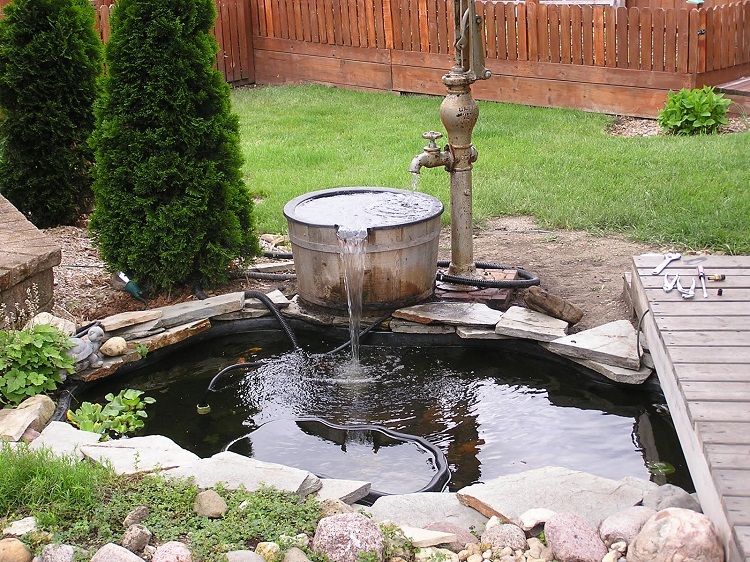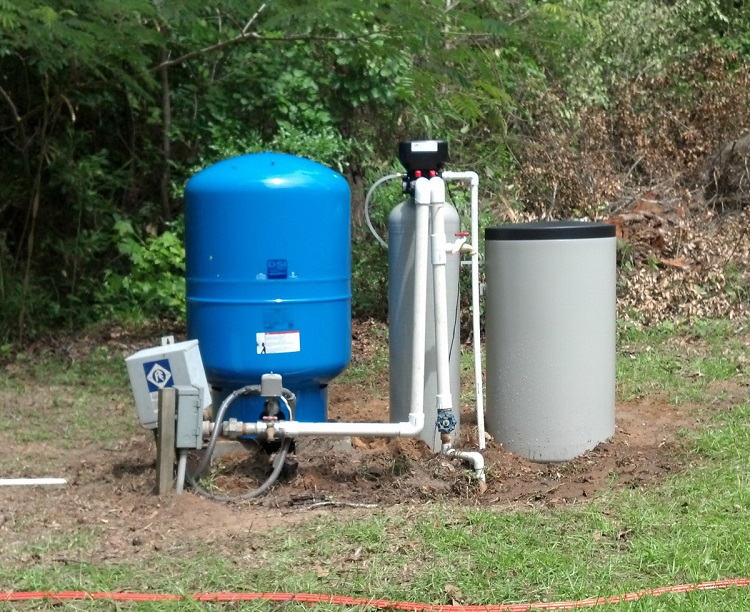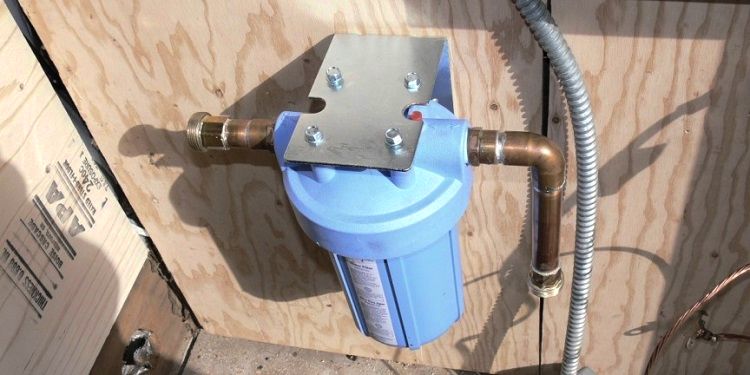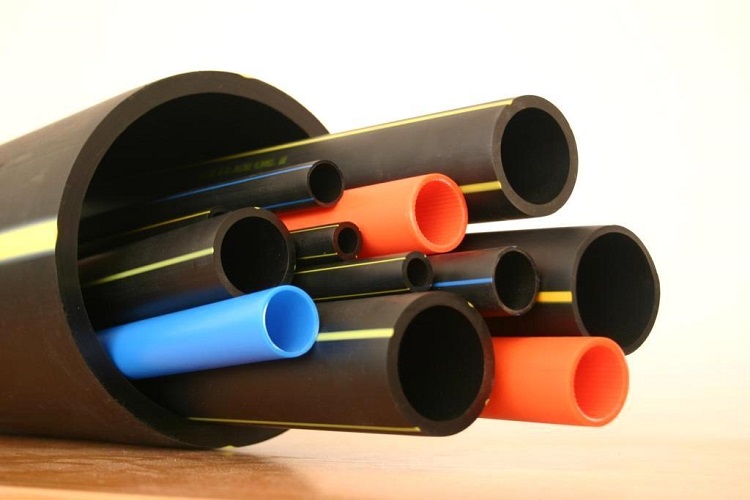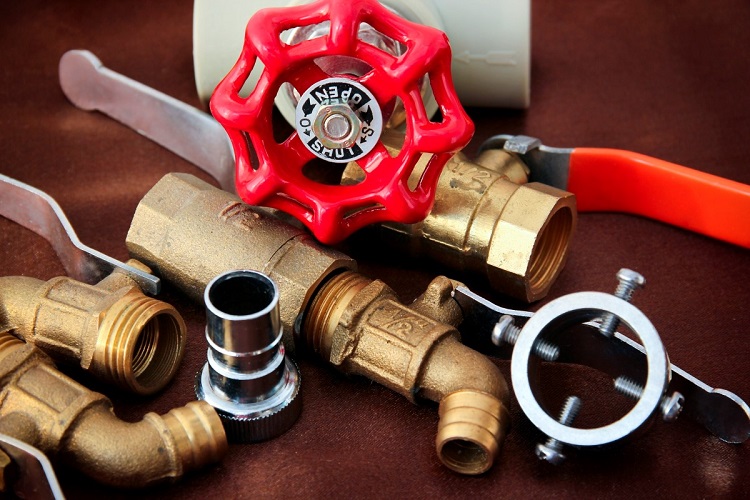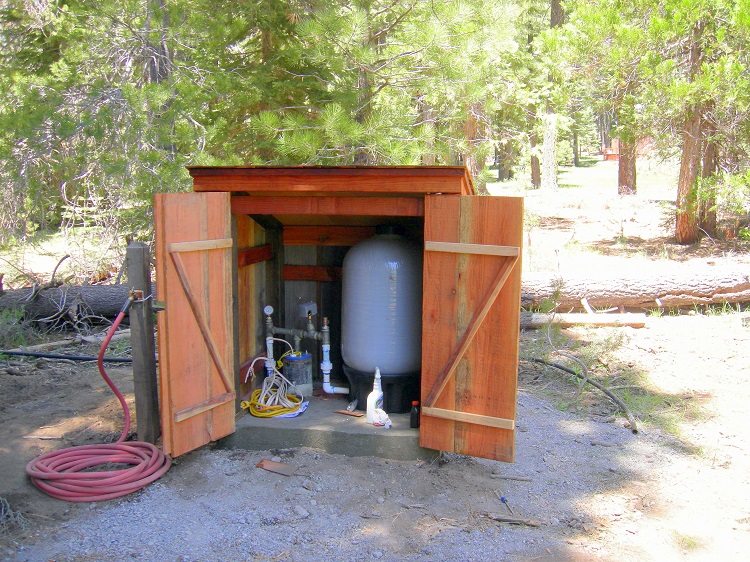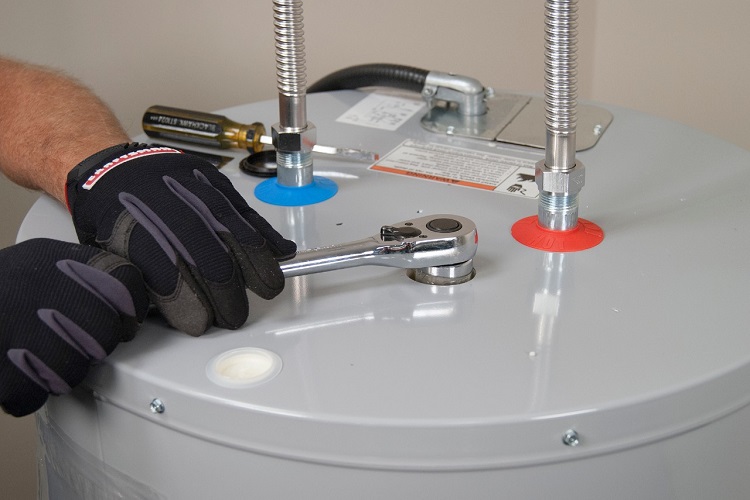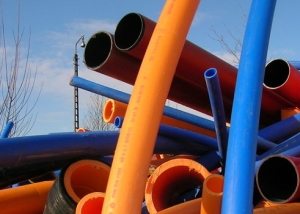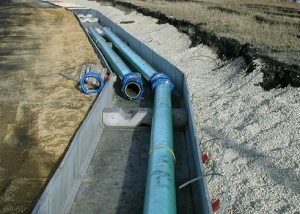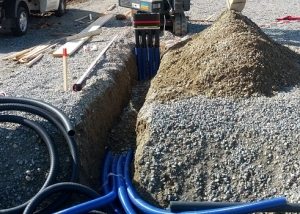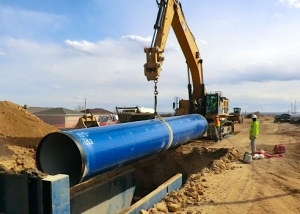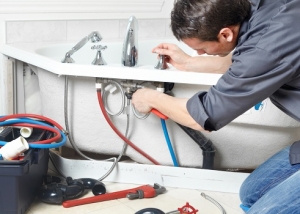Water supply and sewerage in a private house is an integral element of a comfortable life. Their presence provides a minimum level of comfort - the ability to quickly cook food, wash dishes, and satisfy basic hygiene needs. Water supply and sewerage in a private house can be equipped both initially and by passing water to a previously erected and inhabited building.
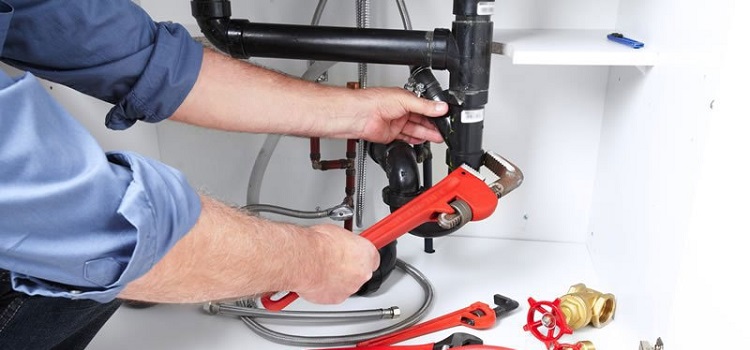
It is not difficult to carry out a water supply to the house, for this you can use different sources of water
Content
- 1 How to connect a water supply system in a private house to a water supply source
- 2 Step-by-step routing of the external trunk
- 3 Diagram of a water pipe, equipped in a private house with your own hands
- 4 The choice of pipes for the water supply in a country house
- 5 Installation of water pipes in a private house
- 6 Doing water piping in a private house with your own hands
- 7 How to connect a pumping station
- 8 Connection of water treatment, collector and water heater
- 9 Service and maintenance
How to connect a water supply system in a private house to a water supply source
Installation of a water supply system in a private house with your own hands begins in order to determine the source of water supply, which can be used as:
- well;
- wells;
- external highway.
From the well
From the private well located on the site, it is quite possible to supply water for the arrangement of the water supply and sewerage in a private house, without involving outside assistants. It is profitable to draw water from your own well into the house, because:
- construction is not particularly difficult and does not require significant costs. To equip the water supply system in a private house with your own hands, you will need to use reinforced concrete rings, tripods with a winch, buckets and shovels. Water supply from a well can be constructed as soon as possible;
- maintenance is not difficult, access to the source will be convenient and simple.
The speed of laying the water supply from the well to the house is associated with the negative sides of this arrangement option:
- in order to avoid siltation, water should be taken continuously;
- water quality in wells is rarely adequate, so a reliable treatment system will have to be installed;
- As a rule, the resources of such a source are very limited, few wells differ in productivity of more than two hundred liters per hour. For a large family, this can be a serious limitation;
- there is always the possibility of pollution by algae, animals and insects, the penetration of rainfall, floods. You will often have to clean and disinfect the water.
Do-it-yourself water supply from the well into the house, using the water supply:
- surface pumping station. This economical option is applicable with a well depth of not more than eight meters. If the well is only a few meters away from the building, then the station is placed right in the house;
- submersible pump. You can not do without it if the well is deep and / or located at least ten meters from the house.
The water supply device from the well is acceptable:
- with a low level of water consumption;
- the presence of a powerful protected source with good water;
- if it is impossible to use other options.
From the well
Laying from a water supply well in a private house is associated with significantly greater costs. Private, conducted from the well, the water supply can be equipped according to one of three options. Possible construction:
1. A driven well (Abyssinian well). The advantages of this option are:
- low construction costs, possible only in soft soil with a shallow aquifer;
- the source can be installed directly in the basement of the house, which eliminates the need to lay an external pipeline and the need for insulation.
There are so many drawbacks in driven wells that they rarely resort to their construction:
- low productivity;
- unreliable water quality;
- the difficulty of ensuring normal functioning.
2. Wells in the sand. By constructing a water supply system in a private house with their own hands, such a well is launched in a couple of days, attracting small-sized equipment. Such a well will last at least fifteen years, and its operation is fraught with problems such as:
- seasonal differences;
- the need for constant water intake;
- the difficulty of cleaning when silting.
3. Artesian wells. Costs, compared with the construction of a well on sand, increase by an order of magnitude. Benefits:
- many years of operation;
- obtaining the purest water that can be supplied from depths exceeding one hundred meters.
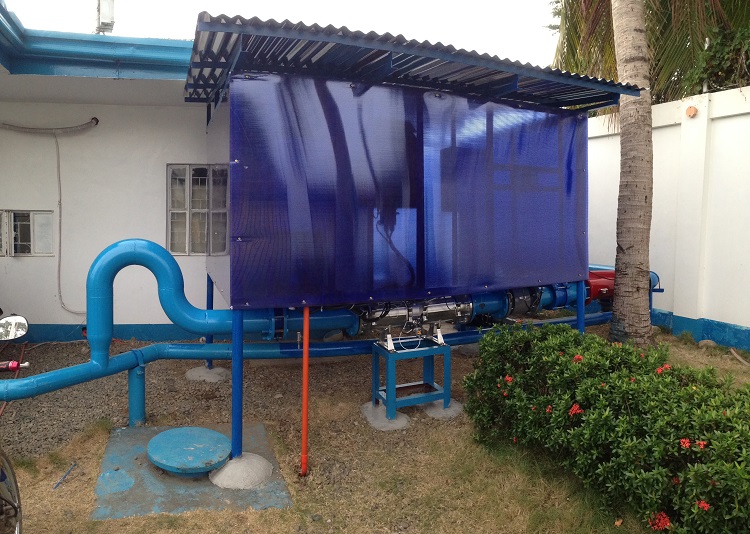
You can connect to a centralized water supply, but this requires permission from the appropriate service
From the centralized water supply
The easiest way is to connect to a centralized water supply. The organization that owns the water system will need to obtain official permission to connect. Obtaining official permission is associated with stipulating the conditions for connection and water use. The owner of the house is provided with a diagram indicating the location of the object to which the connection is made, and recommendations for laying the pipeline.
Step-by-step routing of the external trunk
When installing a water supply system in a private house with your own hands, laying an external highway is carried out in the following order:
- The source and the place where the pipe enters the building are connected by a trench, which is desirable to lay in a straight line with a slope going towards the source. A depth of one and a half to two meters will be sufficient so that the pipe lies below the usual level to which the soil freezes. The bottom of the trench is rammed, covered with a layer of sand and gravel.
- In the hole with a diameter of 40-50 mm, made in the wall in the upper ring of the caisson (well), a special glass is installed to enter the pipe.
- The foundation of the house should be equipped with the same hole, which is equipped with a thermally insulated and waterproof sleeve, into which the pipe will be introduced.
- A pipe with a diameter of 32 mm is brought into the house for connection to a pumping station, and the other end is fed to the source, placing a filter at its end.
- Having laid the pipe along the bottom of the trench, cover it with a heater, after which it is backfilled.
Diagram of a water pipe, equipped in a private house with your own hands
Water supply schemes for a private house, built by yourself, regardless of the source of water supply, are reduced, in essence, to two main types:
- With serial connection (tee wiring). With a serial connection, it is understood that the first consumers consume the bulk of the water, and the subsequent ones will not be able to use the water supply services until they are provided first, in view of the pressure drop in the system.The scheme is quite satisfactory for a private household, from which water will not flow to the next house, and the simultaneous use of several taps can be avoided.
- With parallel connection (collector wiring). Water supply to each consumer is carried out from the collector, and not directly from the source.
Preparing to do the laying of the water supply in the house with their own hands, the scheme is carefully drawn up, taking into account each element that will go into the water supply and sewage system. Schemes are publicly available, including those officially approved by the responsible state authorities. They are easy to correct, bringing in line with the characteristics of private home ownership. The scheme and a simple drawing must necessarily include the presence of:
- pipeline;
- submersible pump or pump station (when connected to an autonomous source);
- water meter unit (when connected to centralized water supply);
- accumulator (not in all cases);
- water treatment systems;
- automatic devices for controlling installed equipment for supplying and heating water;
- plumbing and faucets;
- water heaters;
- shutoff and control valves;
- distribution network;
- Sewerage (drain pit).
When drawing up the scheme, it is desirable:
- reduce the length of the pipeline and the number of connections to the smallest possible value, preventing leakage;
- avoid right angles to prevent pressure drop in the system;
- as far as possible, foresee the possibility of refusing open laying
The choice of pipes for the water supply in a country house
In anticipation of the installation of a water supply system in a private house, making preliminary calculations, they are determined with the diameter and material of the pipes. In a country house, the diameter of the products is selected based on the length of the pipeline:
- less than 10 m - 16-20 mm;
- up to 30 m - 25 mm;
- over 30 m - 32 mm.
It's important to know! The pipe for the collector is selected taking into account the simultaneous use of points of drawing. This value is reduced by about a third, getting a value corresponding to the total water consumption by all the inhabitants of the house. About five liters pass through one tap per minute, and an inch pipe lets thirty liters pass during this time.
Do-it-yourself water distribution in a private house is carried out using pipes that are made of:
- steel. The material is strong and durable, but quite expensive, prone to corrosion, heavy, requires threading or welding, which in a private house is associated with inconvenience;
- copper. The best material in all respects, with the exception of one - a very high price;
- metal plastic. Not susceptible to corrosion and overgrowing, UV radiation and the formation of condensation, bend well. Need expensive metal fittings, frost-resistant, threaded connections will need to pay attention and time to tighten;
- polyethylene. Frost-resistant and ductile. Products made of cross-linked polyethylene will cost more, but they are connected by fittings, without welding;
- PVC Installation for domestic water supply system is undesirable due to the chemical activity of the material that releases unsafe substances into the water;
- polypropylene. Connections are made by the welding machine. PP pipes are characterized by low cost, ease, tight joints, ease of installation and durability.
Installation of water pipes in a private house
Having chosen the most economical option for purchasing pipes for the equipment of the water supply system of a private house with their own hands, they begin to connect them. The sequence of operations is as follows:
- With special scissors, the products are cut at right angles into segments of the desired length.
- On the obtained segments, the welding depth is noted. The place of welding is cleaned of dust, dirt and grease stains.
- Having installed nozzles of the required diameter on the welding machine, they turn it on, warming up to a 260-degree temperature.
- Pieces of pipes intended for welding are worn on nozzles, avoiding rotational movements. After five to seven seconds, the pipe sections are carefully removed.
- The connection of the prepared sections is made by quick and accurate movement, without rotation. They snuggle for a few seconds.
The connection has been made, but you need to give it time to cool before the installation begins.
Doing water piping in a private house with your own hands
After connecting the pipe segments, they proceed to laying the water supply inside the building. It is recommended to start laying from the consumer. The pipe is connected to the water consumer by means of an adapter with a threaded connection. Providing for further repairs, a ball valve is installed, which takes place between the adapter and the hose connected to the valve. If necessary, repair with a ball valve will shut off the water. Next, the pipe is laid to the collector with the mandatory installation of shutoff valves, which allows disconnecting the consumer from the system for repairs or for another purpose.
When wiring a water pipe in a private house, adhere to such requirements:
- avoid, if possible, laying pipes through the elements of building structures. When laying through the wall, the pipe is placed in a special glass;
- facilitating access to pipes in case of repair, they should be laid away from the wall, at least a couple of centimeters;
- approaching the outer corner, the pipe is removed a half centimeter from it. From the inner corner, the pipeline segment is retracted three to four centimeters;
- to attach products to the walls, use single or double clips, placing them on straight sections at a distance of no more than one and a half to two meters from each other. Fixing corner joints is mandatory;
- Docking PP products at an angle, use special fittings, tees, allowing the connection of products of the same and different diameters;
- installation of a drain valve (and a hydraulic accumulator) requires a slight bias in its direction.
Compliance with simple rules will allow you to successfully conduct wiring and achieve proper operability of the installed system.
How to connect a pumping station
The water supply device when supplying water from a well or well, deep and / or quite distant, requires the use of a pumping station. Position it in such a way as to provide sufficient protection against freezing, which will allow you to use the water supply system on frosty winter days. To accommodate the pumping station can be used:
- ground floor;
- basement;
- heated technical room;
- bathroom or kitchen.
The source of water intake is connected to the pumping station via a pipe with a completion in the form of a brass fitting equipped with an adapter. A tee and a drain tap are connected to the fitting. This will allow, if necessary, to begin repair work on the water supply, turning off the water supply. The next step is to connect a non-return valve, by setting which, it will be possible to exclude the movement of water in the opposite direction and the station is idling. If it is necessary to turn the pipe directed to the station, a 90º angle is set.
It is advisable to connect all the following elements with the help of an American:
- ball valve that turns on and off the water supply;
- strainer to perform rough cleaning;
- when the pump is located at the source of water intake from the bottom of the pipe, a damper tank or a hydraulic accumulator are connected, and a pressure switch is connected at the top (the pump station is equipped with both elements, so you don’t have to connect them);
- a sensor that protects the pump from idling;
- fine filter;
- transition to an inch pipe.
Note! The transition to subsequent work is carried out after checking the serviceability of the connection. The lack of water pumping after the start of the pumping station is due to the improper implementation of any connection or pumped pump accumulator.
Connection of water treatment, collector and water heater
Water from the accumulator or storage tank should be in the water treatment system. The devices included in the system are installed half a meter away from the accumulator. The selection of the necessary elements for filtration and deferrization is carried out upon receipt of the results of verification of water samples in the laboratory. The check will reveal the content and concentration of impurities contained in the water from the well or well. Then it will become clear what water should be purified from, and what devices should be installed in order to protect health.
The past filtration system separates the water flow. One line is sent to the collector, the second to the water heater, so that the individual water supply system provides consumers not only with cold water.
In front of the collector, shutoff valves and a drain valve are installed. Each of the wiring lines leading from it to consumers is equipped with similar elements. An individual water supply system should include a device that provides hot water. On the pipe leading to the water heater, install:
- safety valve;
- expansion tank.
Directly under the water heater - a ball drain valve. One more ball valve can not do at the exit. Next, the pipe is led to a hot water collector, from which pipes will be routed through the building.
Important to remember! The connection of an electric water heater is connected with the obligatory grounding and lightning protection.
Installation is completed by conducting a check to make sure that the system is working and that there are no leaks.
Service and maintenance
The water system, equipped in a private house, requires constant attention. Spare tanks need periodic washing and cleaning, threaded connections - pulling up, the outer sections of the pipeline - painting, and the sections of the pipeline laid in the trench should be provided with reliable insulation. If a problem arises, it is worthwhile to fix it immediately so as not to aggravate the situation. In case of a small breakthrough, a bandage with a rubber gasket that is much larger in size is attached to the damaged area, secured with a clamp (screed).
Leakage can also be eliminated with a brace. The rubber gasket is replaced with fiberglass wrapped around the damaged section of the pipe at least six times. The use of epoxy resin will allow you to reliably glue the bandage.
Note! Short-term repairs are carried out by cold welding, when a non-greasy leak is covered and after ten minutes the leak is closed.
If a fistula occurs in a new pipeline, repairs can be carried out by screwing a bolt into a hole drilled under it. This method can not be used, eliminating the fistula in the old pipe, since the thread will only increase it.
The presence of a water supply system is a sign of the standard of living of the inhabitants of the building meeting the minimum requirements for comfort and hygiene. To equip the water supply and sewerage system in a private household is a troublesome task, but quite feasible, if one sets such a goal.
